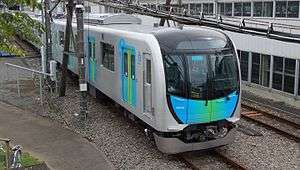Seibu 40000 series
| Seibu 40000 series | |
|---|---|
|
Set 40101 at Kotesashi Depot in September 2016 | |
| In service | Spring 2017 (scheduled) |
| Manufacturer | Kawasaki Heavy Industries |
| Built at | Kobe |
| Constructed | 2016- |
| Number under construction | 70 vehicles (7 sets) |
| Number built | 10 vehicles (1 set) |
| Formation | 10 cars per trainset |
| Fleet numbers | 40101- |
| Operator(s) | Seibu Railway |
| Line(s) served | |
| Specifications | |
| Car body construction | Aluminium alloy |
| Car length | 20,000 mm (65 ft 7 in) |
| Width | 2,808 mm (9 ft 2.6 in) |
| Doors | 4 pairs per side |
| Maximum speed | 120 km/h (75 mph) |
| Traction system | PMSM-VVVF |
| Electric system(s) | 1,500 V DC |
| Current collection method | Overhead catenary |
| Track gauge | 1,067 mm (3 ft 6 in) |
The Seibu 40000 series (西武40000系) is a commuter electric multiple unit (EMU) train type on order by the private railway operator Seibu Railway in Japan for entry into service from spring 2017.[1] A total of eight ten-car trainsets are to be built by Kawasaki Heavy Industries in Kobe from 2016, with the first trains entering service in spring 2017.[1]
Design
The new 40000 series trains will be built by Kawasaki Heavy Industries in Kobe from January 2016, with deliveries from fiscal 2016 to 2019.[2] This is the first time that trains for Seibu Railway have been built by this manufacturer.[2]
The new trains are designed as an evolution of the 30000 series "Smile Train" concept, and are intended to be passenger-friendly.[1] The trains use PMSM (permanent magnet synchronous motors).[1]
Operations
The 40000 series trains will operate on Seibu Ikebukuro Line, Seibu Shinjuku Line, and Seibu Haijima Line services.[3] Some trainsets will be able to operate on through-running services via subway lines,[3] with reserved-seat supplementary-fare services planned between the Seibu Ikebukuro Line and Tokyo Metro Yurakucho Line on weekdays and services between the Seibu Chichibu Line and Minato Mirai Line (via the Tokyo Metro Fukutoshin Line and Tokyu Toyoko Line) at weekends.[4]
Interior
Passenger accommodation will consist of longitudinal bench seating, but some trainsets will feature rotating pairs of seats that can be arranged in either longitudinal or transverse arrangements.[1] LED lighting will be used in the interiors, and LCD passenger information screens will be provided above the doorways.[1] "Partner zone" areas will be provided with perch seats and space for wheelchairs and large luggage. These areas will also have larger windows.[1] "Plasmacluster" air-purification technology will be used for the first time on Seibu Railway trains.[3]
History
Details of the new trains were officially announced in August 2015.[1] The first trainset, 40101, was delivered from the Kawasaki Heavy Industries factory in Kobe to Seibu's Kotesashi Depot in September 2016.[5]
See also
- Tobu 50090 series, a Tobu Railway commuter EMU type that also features rotating longitudinal/transverse seating
- Keio 5000 series (2018), a Keio commuter EMU type that also features rotating longitudinal/transverse seating
References
- 1 2 3 4 5 6 7 8 西武鉄道、新型通勤車両「40000系」を導入へ 初の「パートナーゾーン」も設置 [Seibu Railway to introduce new 40000 series commuter trains - Will include "partner zone" for first time] (in Japanese). Japan: Tetsudo Shimbun. 24 August 2015. Archived from the original on 4 March 2016. Retrieved 12 September 2016.
- 1 2 川崎重工、西武鉄道から新型車両「40000系」80両を受注 [Kawasaki Heavy Industries wins order for 80 new 40000 series vehicles from Seibu Railway] (in Japanese). Japan: Nikkan Kogyo Shimbun, Ltd. 25 August 2015. Archived from the original on 29 August 2015. Retrieved 12 September 2016.
- 1 2 3 進化した”スマイルトレイン” 西武鉄道、新型車両「40000系」デビューへ [New Seibu 40000 series "advanced Smile train" rolling stock to debut] (in Japanese). Japan: Tetsudo Shimbun. 24 August 2015. Archived from the original on 3 August 2016. Retrieved 12 September 2016.
- ↑ 西武・メトロ・東急、座席指定制の直通列車を2017年春に導入へ [Seibu, Tokyo Metro, and Tokyu to introduce reserved-seat through trains in spring 2017] (in Japanese). Japan. 16 June 2016. Archived from the original on 16 June 2016. Retrieved 16 June 2016.
- ↑ 40000系 小手指車両基地へ到着 [Seibu 40000 series arrives at Kotesashi Depot]. RM News (in Japanese). Japan: Neko Publishing. 12 September 2016. Archived from the original on 12 September 2016. Retrieved 12 September 2016.
External links
| Wikimedia Commons has media related to Seibu 40000 series. |
- Official news release (Japanese)
- Kawasaki Heavy Industries press release (Japanese)

